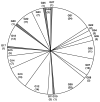Characteristics of Streptococcus mutans genotypes and dental caries in children
- PMID: 23659236
- PMCID: PMC3652634
- DOI: 10.1111/eos.12044
Characteristics of Streptococcus mutans genotypes and dental caries in children
Abstract
This longitudinal cohort study evaluated the diversity, commonality, and stability of Streptococcus mutans genotypes associated with dental caries history. Sixty-seven 5- and 6-yr-old children, considered as being at high caries risk, had plaque collected from baseline through 36 months for S. mutans isolation and genotyping using repetitive extragenic palindromic-PCR (4,392 total isolates). Decayed, missing, or filled surfaces (dmfs (primary teeth)/DMFS (secondary teeth)) for each child were recorded at baseline. At baseline, 18 distinct genotypes were found among 911 S. mutans isolates from 67 children (diversity), and 13 genotypes were shared by at least two children (commonality). The number of genotypes per individual was positively associated with the proportion of decayed surfaces (p-ds) at baseline. Twenty-four of the 39 children who were available at follow-up visits maintained a predominant genotype for the follow-up periods (stability) and this was negatively associated with the p-ds. The observed diversity, commonality, and stability of S. mutans genotypes represent a pattern of dental caries epidemiology in this high-caries-risk community, which suggests that fewer decayed surfaces are significantly associated with lower diversity and higher stability of S. mutans genotypes.
© 2013 Eur J Oral Sci.
Conflict of interest statement
Figures


References
-
- Fejerskov O. Changing paradigms in concepts on dental caries: consequences for oral health care. Caries Res. 2004;38:182–191. - PubMed
-
- Takahashi N, Nyvad B. Caries ecology revisited: microbial dynamics and the caries process. Caries Res. 2008;42:409–418. - PubMed
-
- Berkowitz RJ. Acquisition and transmission of mutans streptococci. J Calif Dent Assoc. 2003;31:135–138. - PubMed
-
- Seow WK. Biological mechanisms of early childhood caries. Community Dent Oral Epidemiol. 1998;26:8–27. - PubMed
Publication types
MeSH terms
Substances
Grants and funding
LinkOut - more resources
Full Text Sources
Other Literature Sources
Medical
Miscellaneous

